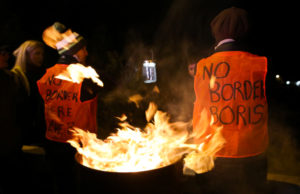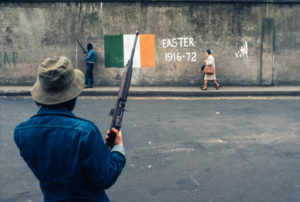Outside of a handful of busy seaports, the population of Britain between the Norman Conquest and the Fifties was extraordinarily stable. But Irish migration to Britain was huge, even if it is usually left out of the noble lie we like to tell ourselves about being a “nation of immigrants”. Not only did the arrival of so many Irish people — especially in the 19th century — generate local tensions and frequent sectarian flashpoints, but it also made Ireland’s constitutional future a live political issue in England, Scotland and Wales.
Irish communities have long shaped politics on the British Isles. It’s largely forgotten now but until well into the 20th century, Liverpool was the most Tory city in England. In the first general election of 1910, 11 of the 13 Merseyside constituencies returned a “Unionist” (as the Conservatives were referred to), outnumbering one solitary Liberal and, uniquely for the mainland United Kingdom, one Irish Nationalist, T.P. O’Connor, who represented the Liverpool Scotland constituency from 1885-1929.
The decisive factor in the strength of Unionism in Edwardian Liverpool was its proximity to Ireland, and the presence of so many Irish people in the industrial towns of Northern England and Scotland. The Third Irish Home Rule Bill mattered to the rest of the public in the later Edwardian period because of the enduring importance of the Union, the Empire and Protestant Christianity in the matrix of British national identity at the end of the long 19th century — an identity which had emerged from the febrile era of Foxe’s Book of Martyrs and the Gunpowder Plot, and then the centuries of wars with Catholic Spain and France.
Yet popular opposition to Irish Home Rule in the years before the First World War has been almost entirely memory-holed in British history. In the two years from 1912, the Ulster Unionist leader Sir Edward Carson toured Britain to thump the tub for “Loyal Ulster” remaining in that Union, and outside the jurisdiction of a Dublin parliament. No other contemporary political campaign could match that led by Carson for the breadth and intensity of its appeal. Although William Gladstone is remembered for addressing over 83,000 in the course of his famous Midlothian Campaign in the 1880s, Carson probably addressed 10 times that number in the years before the First World War. By 1914, the future of Ulster was, in the words of the Times, “not only the subject, but the scenes of all political interest” — a fact that might surprise a British public that has grown increasingly apathetic about Northern Ireland. Few have followed the twists and turns over sausages and seed potatoes in the post-Brexit negotiations with the EU with much interest.
Historical amnesia is especially acute in the Socialist Republic of Merseyside, where Liverpudlians routinely boo the national anthem and revel in anti-Unionist “Scouse not English” identity. This has completely airbrushed out the local traditions of plebeian Orangeism, and the fact that Liverpool FC was founded by the Orangeman and Conservative Lord Mayor of the City, Sir John Houlding. It is telling, of course, that after signing the famous “Ulster Covenant” against Irish Home Rule in 1912, it was to Liverpool that Carson sailed from Belfast. He was then met by a vast and rapturous crowd of over 150,000 at the Pier Head, before a torchlight procession led by Orange Order bands progressed in triumph through the city.
It was more like Palm Sunday than an ordinary political gathering, and the religious overtones in the anti-Home Rule campaign are obvious. In fact, the Home Rule crisis, between 1912 and 1914, was the last time religion seriously mattered in British politics. As Linda Colley argued in Britons: Forging the Nation, Catholics were the archetypal “other”, helping to unite the kingdom. In fact, it is useful to see the events of 1912 to 1914 as the culmination of a sequence of flash points — from Catholic emancipation in 1829 to the debates around Irish church disestablishment in 1869, from the Home Rule Bills of 1886 and 1892 to the changes to the British coronation oath in 1910, which removed those passages judged offensive to Catholics.
All of these episodes were given added piquancy in Britain by the arrival of the Catholic Irish in massive numbers in the middle of the nineteenth century. But it is important to remember that Irish migration included Protestants too. Hence events such as the huge sectarian riots that rocked Liverpool in 1909 — probably sparked by a provocative procession through Everton led by a pig carcass bearing the insult “Cured at Lourdes”.
Inter-Irish tension was exploited skilfully by the leadership of the Unionist party in this period — notably by Andrew Bonar Law, an unscrupulous Scots-Canadian of Ulster Presbyterian stock. Having been an MP in Glasgow and Liverpool, Law well understood the emotions that the Irish question generated — and how playing the “Orange card”, as Randolph Churchill had done against Gladstone in 1886, could rescue the Unionist party from the doldrums. He once proclaimed in a speech in 1912 that he could “imagine no length of resistance to which Ulster will go which I shall not be ready to support and in which they will not be supported by the overwhelming majority of the British people”. For a Leader of His Majesty’s Most Loyal Opposition, Law was playing with fire. It undoubtedly encouraged the Unionists in Ulster, who had recently founded the paramilitary Ulster Volunteer Force, and whose parades were attended on horseback by leading Conservative politicians such as the dissolute Liverpool MP, F.E. “Galloper” Smith, later the 1st Earl of Birkenhead.
But Sir Edward Carson was the main attraction wherever he went. A Dublin-born barrister, known for defending the Marquess of Queensberry in a libel case against Carson’s own schoolmate Oscar Wilde, Carson was the archetypal “charismatic leader”, and a man who was marketed carefully as the embodiment of the Union. Some historians have seen a premonition of fascism in the hero-worship of the lantern-jawed Carson at rallies from Plymouth to Inverness, Norwich to the Rhondda Valley; Professor Roy Foster has even noted his sexual appeal, and the effect this had on the still voteless but enthusiastic women of Northern Ireland and beyond.
What is more, after the rapid industrialisation of Northern and Western Britain, the English, Scots, Irish, and Welsh were no longer neatly confined within their own national territory. Liverpool was a land of opportunity, and though its Irishness is well known, its Scottish links were deep-rooted too (William Gladstone was born in the city to parents from Leith and Dingwall). And by 1900, Liverpool had over 90 Welsh chapels, and even Welsh language newspapers — making it “the capital of North Wales”.
This internal migration within the UK strengthened familial and fraternal bonds, and by extension, the emotional appeal of the Union. Indeed, the nexus between the Lagan, Mersey, Clyde and Tyne formed a kind of northern industrial zone that featured prominently on the itineraries of Carson and others. The pull of sectarian politics explains why Bonar Law focused his national campaigning on opposing Irish Home Rule, not for sentimental reasons, but because of cold political calculation; he even admitted privately to H.H.Asquith that, “Protestantism, or at least dislike of Catholicism”, motivated his core vote.
And his approach was effective. By 1914, Unionist demonstrations were happening all over the country, they had the government on the back foot in parliament and the Liberal Party’s worst by-election performances coincided with the most frenetic period of anti-Home Rule activity. The Unionists had probably mobilised enough of their core vote over Home Rule to have been favourites to win the next general election, planned for 1914 or 1915, but never held because of the outbreak of war.
Extra-parliamentary resistance was gaining support too. By 1914, a “British Covenant” had gained hundreds of thousands of signatories, while the “British League for the Support of Ulster and the Union” was openly drilling armed volunteers in Glasgow, Liverpool and London, in preparation to fight in Ulster. And most alarming of all, the army itself — especially its Anglo-Irish officer caste — was havering on whether they could be relied upon impose Home Rule on Ulster.
This was serious, and far from being the Indian summer of popular memory, Britain in 1914 was arguably on the verge of civil war. Indeed, the Liverpool Courier observed that, “The first blood spilled in Ulster would raise a storm in the large towns of England and Scotland… the problem of the working classes of Liverpool, Glasgow, Barrow, Manchester and Newcastle would be difficult to handle and would be even worse than in Belfast.”
In the middle of all this, an Austrian archduke was shot to death in a Sarajevo side street, and all was changed, changed utterly. Asquith even wrote to his wife saying, “at least we won’t have to talk about Ireland for a while”. But the horrors of the First World War merely postponed the reckoning for Northern Ireland, which eventually achieved a sort of Home Rule that the Ulster Unionists had fought so hard to resist.
Still, attitudes in Britain were changed by the years of war, as class began to overtake religion as a source of identity and political allegiance. Religious observance cratered and the old suspicions of Catholics as a disloyal fifth column were disproved, as soldiers shared hardships with men they would never ordinarily have mixed with in civilian life. Even Robert Graves in his lucid war memoir, Goodbye To All That, noted that despite being raised with “a horror of Roman Catholicism”, he and his fellow soldiers developed a huge respect for the gallantry of the RC padres, who went into the battle line to give extreme unction to the dying. Even in Liverpool, where they still hold rather desultory Orange marches every year on the Glorious Twelfth, sectarian tensions waned, not least because — unlike Glasgow — the city’s two main football teams never really developed unambiguous Protestant or Catholic identities.
Until the Scottish independence referendum in 2014, the Union hadn’t been the central focus of British politics for precisely 100 years. Even the 30 years of terrible violence during The Troubles never really made any difference to how people voted in the United Kingdom. Unlike the Edwardian hero-worship of Carson, by the end of the century, the fulminating Ulsterman had become a figure of ridicule, and Unionism itself was becoming such a low-status opinion that many British people — especially the more disgruntled and online Remainers — began to express support for both Scottish independence and Irish unification, experiencing no cognitive dissonance whatsoever. The challenges that Brexit posed Ireland may have been surmounted by the Windsor Agreement. The SNP may yet find a charismatic new leader. But it remains to be seen whether the ideal of the United Kingdom will trouble the British public enough for them to fight for it.
Disclaimer
Some of the posts we share are controversial and we do not necessarily agree with them in the whole extend. Sometimes we agree with the content or part of it but we do not agree with the narration or language. Nevertheless we find them somehow interesting, valuable and/or informative or we share them, because we strongly believe in freedom of speech, free press and journalism. We strongly encourage you to have a critical approach to all the content, do your own research and analysis to build your own opinion.
We would be glad to have your feedback.
Source: UnHerd Read the original article here: https://unherd.com/




